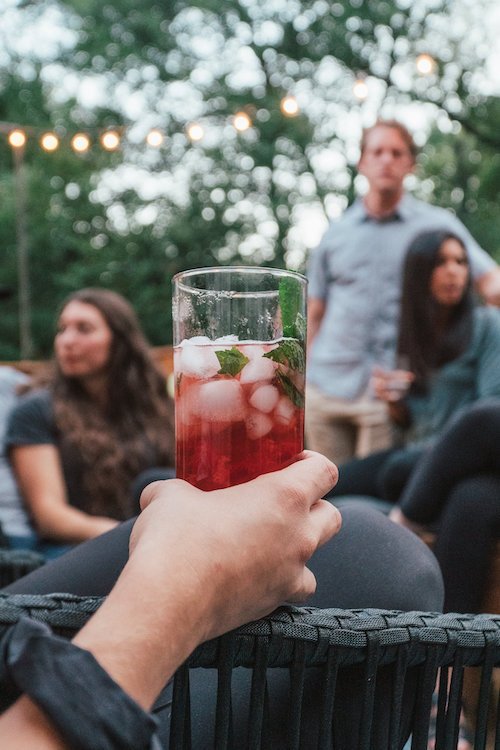Managing Alcohol Intake When You Have Nutrition Goals
One of the very first things I do when I want to clean up my nutrition, regardless of whether I’m working towards performance or fat loss goals, is take inventory of my weekly alcohol consumption. Alcohol is one of those things where it’s fairly easy to feel like you’re keeping yourself in check, but in reality may be sneakily impeding your progress.
While you may only be having a drink or two on any given day, multiple drinks across a week can really add up (especially if you’re not accounting for your drinks).
Let’s say you have a 7 oz. glass of white wine every day with dinner. Each glass of wine is about 175 calories, give or take a bit. Your nightly drink adds up to almost 1,200 extra calories per week from alcohol - a fourth macronutrient that has no nutritional value and doesn’t support any of your body’s functions.
If working towards fat loss, alcohol consumption may not help you adhere to a consistent calorie deficit.
HOW TO TRACK ALCOHOL
Before I get into my suggestions for managing alcohol consumption while still working toward your goals, let’s discuss the preferred method for tracking alcohol as part of your overall macros. The calories in pure alcohol are not classified as protein, carbs, or fats. This means that you can’t log a drink accurately by just scanning the barcode; however, it does mean that you get to decide how you want to account for your drink. You can choose whether you want to track it as carbohydrates or fats or a mix of the two.
EXAMPLE | A 5oz glass of red wine is listed as 129 calories in MFP (0P/0F/4C). If you log this red wine as is, you are only accounting for 4 grams of carbohydrates, or about 16 calories. This leaves you with 113 calories that are simply not accounted for, but have indeed been consumed..
In order to track more accurately, the best practice is to track alcohol as either carbs, fat, or a combination of the two. Doing this rather than just inputting the existing listings in MFP will allow you to still hit your macro targets perfectly.
If tracking using carbohydrates: 129 calories divided by 4 cal/g = 32g carbs
If tracking using fat: 129 calories divided by 9 cal/g = 14g fat
If tracking using a combination:
64.5 calories divided by 4 cal/g = 16g carbs
AND
64.5 calories divided by 9 cal/g = 7g fat
HOW TO DRINK
Now that we have that covered, here are my suggestions for how to approach alcohol consumption -- especially if you have goals to improve performance or lose fat.
THINK OF A DRINK LIKE A DESSERT || Some people suggest you have a drink OR dessert but never both (especially when eating out or traveling). Both desserts and alcohol don’t contribute to your overall health nutrient-wise, so having both is unlikely to leave you feeling full and satisfied for long. Both can also be high in calories, so having them together can derail your nutrition for the day in a hurry.
KEEP YOUR MIXERS TO A MINIMUM || Many cocktails contain liqueurs, juices, and syrups for sweetness that can easily add 15-30g of carbs per drink. Sticking with light beer, dry cider or wine can help avoid some extra calories. You can also have your favorite liquor with seltzer water or diet soda.
PICK A LIMIT AND STICK TO IT || This is especially helpful if you’re going to be at a social event (parties, tailgating, or anything else where people are having multiple drinks). Decide how many drinks you’re willing to budget in before you have your first drink. If you don’t have a firm number, it’s easy to overdo it. Because alcohol lowers inhibition, two drinks can easily turn into three or four -- and then the pizza smells too good to say no to, and you’ve lost track of how many handfuls of chips you’ve eaten. Pick your limit and don’t go over!
Alcohol is fine for most diets in moderation. However, if you are on a fat loss diet and already struggling with compliance, that lower inhibition after a drink may make it very hard to stay on track. If that’s the case, it may be wise to cut alcohol consumption as much as possible, at least until you’re comfortably able to stay compliant without it feeling like a struggle.
Because alcohol doesn’t contain anything that makes you feel full, it can be easy to overdo. Having some go-to strategies for when you do have a drink will help prevent that drink from derailing your nutrition goals.
The “How to: Fitness” podcast is just one of many avenues in which I share health and nutrition education. You can find more episodes here on Apple Podcasts or here on Spotify, or wherever else you listen to podcasts.
We get it—fat loss can feel complicated and overwhelming. For personalized support that works with your lifestyle, not against it, sign up for 1:1 Nutrition Coaching. Let’s make your nutrition supportive, not just another source of stress.
